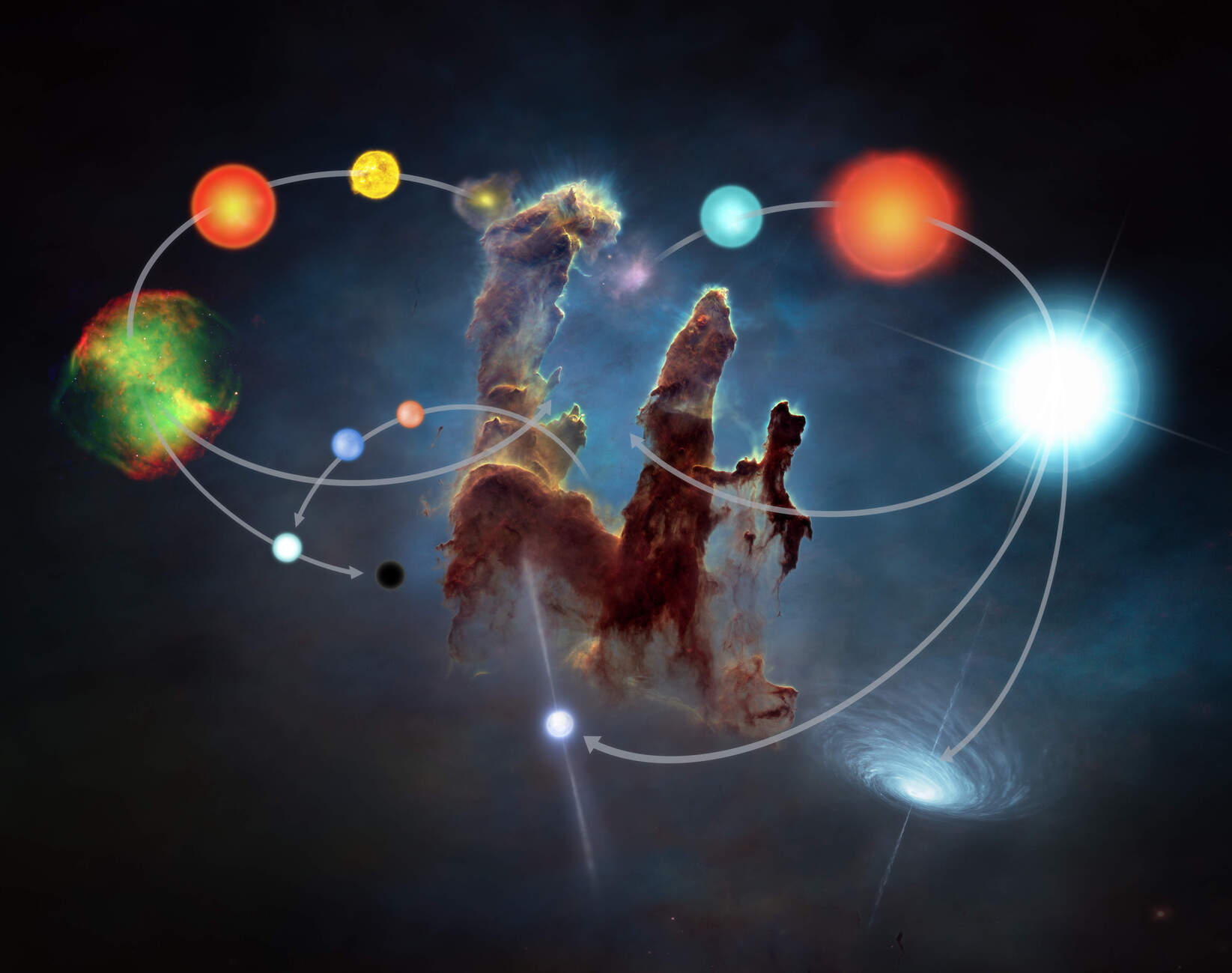
The vast and mysterious expanse of the universe never ceases to amaze us. Among its many wonders are the mesmerizing celestial bodies called stars, which play a crucial role in shaping our understanding of the cosmos. As stars evolve over time, they undergo a fascinating transformation known as stellar evolution.
In this article, we will delve into the captivating world of stellar evolution and uncover eight mind-blowing facts that will leave you in awe. From the birth of stars in stellar nurseries to their explosive deaths as supernovae, the journey of a star is a spectacular tale of cosmic forces and intricate processes.
Join us as we explore the incredible phenomena that occur throughout a star’s lifetime, shedding light on the intricate mechanisms that govern the evolution of these luminous giants. Brace yourself for a cosmic adventure that will expand your understanding of the universe and leave you marveling at the wonders of stellar evolution.
Key Takeaways:
- Stars are born in massive clouds and go through different stages, shaping the universe and creating elements crucial for planets and life. Stellar evolution is like a cosmic cycle of birth, transformation, and legacy.
- Stellar nurseries are powerful engines that generate immense energy, while stellar collisions and mass influence the dramatic transformations of stars. From the birth of stars to the creation of black holes, stellar evolution is a mind-blowing cosmic spectacle.
Stars are born in giant molecular clouds
The first mind-boggling fact about stellar evolution is that stars are born within massive clouds of gas and dust called giant molecular clouds. These clouds are so vast that they can span hundreds of light-years in diameter. Within these clouds, gravity causes the material to collapse, leading to the formation of new stars.
Stellar nurseries are powerful cosmological engines
Stellar nurseries, where stars are born, are incredibly dynamic and energetic environments. The gravitational collapse of the gas and dust triggers a series of intense processes, including nuclear fusion, which powers the star throughout its life. These nurseries serve as cosmic engines, generating immense amounts of energy that shape the surrounding interstellar medium.
Stars go through different evolutionary stages
Stars, just like living organisms, go through various stages of evolution. They begin as protostars, gradually converting their gravitational potential energy into thermal energy. As they continue to grow and accumulate matter, they enter the main sequence phase, where they spend the majority of their life. Eventually, stars exhaust their nuclear fuel and undergo dramatic transformations, leading to the formation of red giants, supergiants, or even exploding in a brilliant supernova.
Stellar remnants can form exotic objects
When a massive star reaches the end of its life and undergoes a supernova explosion, the remnants can give rise to some of the most fascinating objects in the universe. Neutron stars, incredibly dense remnants formed after a supernova, are composed almost entirely of neutrons. Another extraordinary outcome is the creation of black holes, regions of spacetime with gravity so strong that nothing, not even light, can escape.
Stellar collisions can occur
In dense stellar environments, such as globular clusters, close encounters and collisions between stars are not uncommon. These collisions can lead to the formation of exotic binary star systems or even trigger powerful explosions called nova or supernova outbursts. The dynamics within these clusters are extremely complex, with stars interacting and exchanging mass throughout their lifetimes.
Stellar evolution is influenced by mass
The mass of a star plays a crucial role in its evolution. High-mass stars tend to burn their fuel at a much faster rate and have shorter lifetimes compared to low-mass stars. Additionally, massive stars go through more extreme transformations, often ending in spectacular supernova explosions. Conversely, low-mass stars, like red dwarfs, calmly burn their fuel for billions or even trillions of years, undergoing a slow and steady evolution.
Elements are synthesized in stellar interiors
Stellar evolution is not only responsible for the creation of various types of stars but also for the synthesis of elements. The intense heat and pressure within a star’s core enable nuclear fusion reactions, which fuse lighter elements into heavier ones. This process, known as nucleosynthesis, is responsible for the production of metals and elements crucial for the formation of planets, including Earth.
Stellar evolution shapes the universe
The continuous cycle of stellar birth and death has a profound impact on the structure and evolution of the universe as a whole. Stellar explosions, such as supernovae, release enormous amounts of energy, dispersing heavy elements into space. These elements serve as the building blocks for future generations of stars, planetary systems, and, potentially, life itself. Stellar evolution is an essential driving force in shaping the vast cosmic tapestry we observe today.
Conclusion
In conclusion, stellar evolution is a fascinating and intricate process that shapes the life cycle of stars. From the birth of stars in massive clouds of gas and dust to their eventual death as white dwarfs, neutron stars, or black holes, each stage exhibits incredible transformations and phenomena. The journey of a star involves nuclear fusion, gravity, and the interplay of various physical forces.By understanding the process of stellar evolution, we gain valuable insights into the origins of our universe and the elements that make up everything around us. It is awe-inspiring to think that the elements in our bodies were once forged in the fiery cores of distant stars.Stellar evolution continues to capture the imaginations and curiosity of scientists and astronomers worldwide. With ongoing research and exploration, we can uncover even more unbelievable facts about the life cycles of stars and the cosmic phenomena that shape our universe.
FAQs
1. What is stellar evolution?
Stellar evolution is the process through which a star undergoes various changes and transformations throughout its lifetime, from its birth to its death.
2. How do stars form?
Stars form from massive clouds of gas and dust called nebulae. These nebulae collapse under their own gravity, forming a dense core that ignites nuclear fusion and initiates star formation.
3. What fuels a star?
A star is fueled by the process of nuclear fusion, where hydrogen atoms combine to form helium, releasing a tremendous amount of energy. This energy helps maintain the star’s temperature and luminosity.
4. Do all stars evolve in the same way?
No, the evolution of stars depends on their initial mass. Low-mass stars, like our Sun, go through stages such as the main sequence, red giant, and white dwarf. High-mass stars undergo more dramatic stages, including becoming red supergiants and eventually exploding as supernovae.
5. What happens when a star dies?
When a star dies, its fate depends on its mass. Low to medium-mass stars become compact objects known as white dwarfs, while high-mass stars may become neutron stars or collapse into black holes.
6. How long does stellar evolution take?
The duration of stellar evolution varies depending on the initial mass of the star. Low-mass stars can live for billions of years, while high-mass stars have much shorter lifetimes, often less than a few million years.
7. Can we observe stellar evolution?
Yes, scientists and astronomers study stellar evolution through observations using telescopes and advanced instruments. By analyzing the light emissions, temperature, and spectral characteristics of stars, we can gain insights into their evolutionary stages.
8. How does stellar evolution relate to the formation of elements?
Stellar evolution plays a vital role in the creation of heavy elements. The intense heat and pressure within stars enable nuclear fusion processes, which synthesize heavier elements like carbon, oxygen, and iron. These elements are then scattered into space when stars go through their lifecycle, eventually becoming part of new generations of stars and other celestial bodies.
Stellar evolution's captivating journey doesn't end here! Continue exploring the cosmos with our articles on Cepheid variable stars' astonishing behavior, star cluster dynamics' surprising intricacies, and white dwarfs' fascinating characteristics. Each topic offers mind-expanding insights into the universe's celestial wonders, promising an enlightening adventure through the vast expanse of space. Prepare to be amazed as you unravel more stellar secrets and expand your understanding of the awe-inspiring cosmos!
Was this page helpful?
Our commitment to delivering trustworthy and engaging content is at the heart of what we do. Each fact on our site is contributed by real users like you, bringing a wealth of diverse insights and information. To ensure the highest standards of accuracy and reliability, our dedicated editors meticulously review each submission. This process guarantees that the facts we share are not only fascinating but also credible. Trust in our commitment to quality and authenticity as you explore and learn with us.


